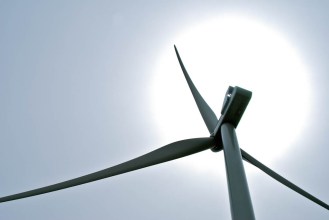
A turbine at Green Mountain Power’s Kingdom Community Wind project on Lowell Mountain. Photo by John Herrick/VTDigger
Connecticut regulators ruled Wednesday that credits purchased from renewable electricity generated in Vermont can count toward that state’s energy goals.
The decision means Vermont utilities can continue to sell their renewable energy credits in the regional marketplace, which brings in about $50 million a year that utilities use to lower electric rates here. The state worried that if Connecticut decided to exclude Vermont RECs, rates in the Green Mountain State would rise by 6 percent or more as soon as next year.
In a long-awaited draft ruling, the Connecticut Public Utilities Regulatory Authority found Vermont’s renewable energy credits are acceptable despite some claims that Vermont RECs are “double counted.” The credits represent the environmental attributes of electricity generated from renewables such as wind and solar and are purchased by utilities to meet renewable energy portfolio goals.
Critics of Vermont’s SPEED program argue that Vermont utilities have been counting the same credits toward Vermont’s renewable energy goal that are also sold to out-of-state utilities.
But Connecticut regulators said Vermont law does not establish a tangible renewable energy goal until 2017. As a result, Vermont utilities before that would not be applying the credits toward any real goal. The Shumlin administration has made that very point in defending the program.
“There simply is no direct annual goal between 2012 and 2017 toward which megawatt hours are claimed or counted,” the ruling states. “While there does appear to be an overarching ‘glide path’ goal over that timeframe to increase the percentage of renewable SPEED resources used, no megawatt hours are presently counted toward any identifiable goal today.”
That could change in 2017 when, under the SPEED program, Vermont utilities are asked to source 20 percent of their electricity from renewable energy generation projects built in Vermont. Regulators said if that occurs, the RECs from Vermont would be legally questionable.
The ruling comes one day after the Vermont House passed a new renewable energy policy to address the perception of double-counting. The bill, H.40, replaces Vermont’s SPEED program with the so-called RESET program that would take effect in 2017.
“Proposed legislation in Vermont, if enacted, would provide more certainty today that SPEED 2017 goals would be administered in a way that is entirely compatible with other state RPS programs,” the ruling says.
H.40 was introduced to the House Natural Resources and Energy Committee in January. The Department of Public Service said one of the reasons for pursuing the legislation was because utilities were having difficulty selling renewable energy credits in New England. These sales represent a $50 million source of revenue for utilities; without it, there would be a 6 percent statewide rate increase, DPS has said.

Darren Springer, deputy commissioner of the Department of Public Service, provided the department’s recommendation for a net metering program to the House Committee on Natural Resources and Energy. Photo by John Herrick/VTDigger
Darren Springer, deputy commissioner of the Vermont Department of Public Service, said H.40 is still necessary. He said regulators made clear that by 2017, the “SPEED program may trigger a claim” resulting in the loss of REC sales for Vermont utilities.
“We don’t want to leave that type of uncertainty on the table for ratepayers,” Springer said. “We want to do something with H.40 that heads off any concerns in 2017.”
He said passing the bill now will give utilities time to adjust to the new regulations. Under RESET, utilities will have to purchase or retire RECs to meet meet state mandates. By 2017, 55 percent of a utility’s electricity portfolio must come from renewables, and up to 75 percent by 2032.
Critics of Vermont’s SPEED program say the ruling confirms the state has no current renewable energy goal. For years, the voluntary program has come under fire from critics who say it doesn’t reduce Vermont’s carbon footprint. The SPEED program was designed to reduce the upfront cost of renewable power generation by allowing utilities to sell RECs for projects built in Vermont.
“What is our goal? I am completely confused now,” said Annette Smith, executive director of Vermonters for a Clean Environment, who was a party on the Connecticut docket calling for an investigation into Vermont’s practices. “We built a lot of renewable energy to serve Connecticut and Massachusetts.”
The three-panel regulatory body, which is part of Connecticut’s Department of Energy and Environmental Protection, sent a letter last December to Gov. Dannel P. Malloy’s office seeking to reinstate their independence, according to a news report.
Smith said the department’s oversight creates a conflict of interest with the Malloy administration’s policy agenda.
“It reeks of political interference. That’s my gut reaction to it,” she said of the decision.
The news was welcomed by Vermont’s largest utility. Green Mountain Power sells renewable energy credits for nearly all of its wind and solar generated in Vermont, bringing in about $30 million per year.
“I think, overall, we view the ruling as good news for customers because it preserved the state’s ability to keep rates low,” said Kristin Carlson, a spokeswoman for Green Mountain Power, which was also a party to the case.
The company says it did not have any trouble selling RECs in recent months. Other utilities, such as Burlington Electric Department, Washington Electric Coop, and the Vermont Electric Coop had difficulty or stopped selling RECs to Connecticut while the decision was pending.
The parties have until March 18 to file a request for oral arguments. Regulators expect to issue a final decision by March 25.
The post Connecticut rules in favor of Vermont renewable energy credits appeared first on VTDigger.